|
|
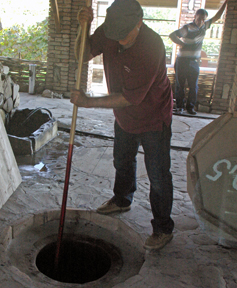 Although we were not present at Twins Wine Cellars at Napareuli to punch down our cap, we did punch down the cap on a large capacity qvevri at the winery. Our previous experience of punching down was at Tin Lizzie Wineworks in Clarksville, Maryland last fall. Kathy and I went to the winery daily and punched down the cap of our fermentation bin and several other clients’ fermentation bins. The caps in the fermentation bins were four to six inches thick. Punch down required a litter effort the first time you punch through the cap, but it was easy after that. Punching down the cap in a large capacity qvevri is an entirely different experience. Although we were not present at Twins Wine Cellars at Napareuli to punch down our cap, we did punch down the cap on a large capacity qvevri at the winery. Our previous experience of punching down was at Tin Lizzie Wineworks in Clarksville, Maryland last fall. Kathy and I went to the winery daily and punched down the cap of our fermentation bin and several other clients’ fermentation bins. The caps in the fermentation bins were four to six inches thick. Punch down required a litter effort the first time you punch through the cap, but it was easy after that. Punching down the cap in a large capacity qvevri is an entirely different experience.
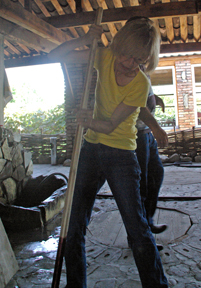 Kathy punching down the cap The cap in a large capacity qvevri is over a foot thick, 0.3 meters. It’s not as easy to punch down the first time. It took a lot of effort and pressure to break through the thick cap. Even subsequent punch downs took a lot of effort. As soon as I had one side punched down and started the other side, the cap where I began was already formed. One has to work quickly and use a lot of force to punch down a qvevri cap. Why was the cap so thick?
The fermentation bin at the Maryland winery was larger at the top and smaller at the bottom. There was more surface area for the cap to form. The design of a qvevri is smaller at the top. There is less space for the cap to fill so the cap is much thicker.
We also punched down the cap at Soliko Tsaishvili’s winery, Our Wine, in Kakheti. We were punching down Rkatsiteli that had been fermenting for ten days. At this point, the cap was less thick and the punch down was much easier. We did learn at Our Wine that after punch down, a worker must use a sponge with clean water to wipe the inside of the qvevri where there are no grapes or wine. During punch down, there is splatter and the sides of the qvevri near the top may become splattered with grapes. Wiping this clean helps eliminate the formation of bacteria.
Cheers,
Terry
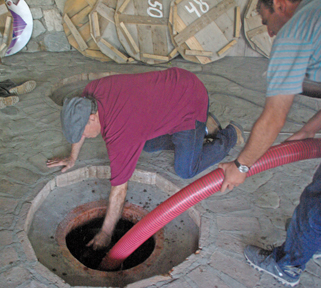 Getting a bucket of grapes and juice from a large capacity qvevri During the morning we helped to harvest Rkatsiteli grapes. By mid-afternoon, the load of grapes arrived at the winery. The protocol at Twins Wine Cellars at Napareuli was to destem the grapes. The stems would be discarded and the destemmed grapes and juice would be pumped to a qvevri. While destemming, some of the grapes’ skins would break releasing the juice. Because of the size of our qvevri, we could not directly pump into our qvevri.
The juice and grapes were pumped into a large qvevri. Once the qvevri filled to within 18 inches of its opening, I was able to put a bucket in a scoop out the juice and grapes. Our bucket held between two and three gallons. It took eight bucket loads to pour into our qvevri. I think we have a minimum capacity of 80 liters, since we left several inches of headspace for the fermentation.
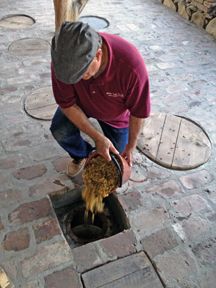 Pouring the grapes into the smaller qvevri No yeast was added to the grapes and juice in the qvevri. The fermentation would begin with natural yeast in a couple days. I did ask several winemakers about stuck fermentation. They said it just doesn’t happen in qvevri. Considering that grapes have been grown in Georgia for 8,000 years, there must be plenty of natural yeast on the skins.
Cheers,
Terry
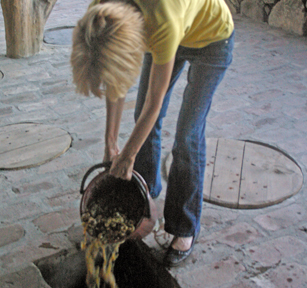 Eight buckets, about 60 liters, of grapes and juice were poured into the small qvevri.
 At home, I am very concerned about making wine in carboys and small plastic fermenters that are clean and sanitized. Sometimes it takes a brush to remove crud. If you just sanitize, you end up with sanitized crud in your fermentation vessel. So I was naturally interested in how to prepare a qvevri for receiving the grapes. At home, I am very concerned about making wine in carboys and small plastic fermenters that are clean and sanitized. Sometimes it takes a brush to remove crud. If you just sanitize, you end up with sanitized crud in your fermentation vessel. So I was naturally interested in how to prepare a qvevri for receiving the grapes.
Our qvevri, at Twins Wine Cellars in Napareuli was over 60 liters in capacity. It was too large to reach the bottom with your arm, so washing it with a hand-held brush wouldn’t work. It was too small to climb into it, so once again a hand held brush would not work. We had to clean the qvevri from above ground. We began by pouring a bucket of fresh clean water into the qvevri. Then using a cleaning tool I brushed the sides of the qvevri. The tool was made of a long handle with a four inch by six inch brush made from cherry bark on the other end. The cherry bark end was strong enough to roughly rub the sides of the qvevri. After a little rubbing the side with the cherry bark, the water needed to be replaced and the process repeated again for five or six times.
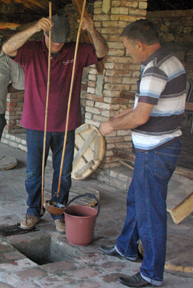 Removing the dirty water at the bottom of the qvevri was also a problem since we couldn’t reach into the qvevri to the bottom. However a small bowl with sticks attached to its sides was used. Manipulating the sticks, one stick could turn the bowl upside down. The upside down bowl was lowered to the bottom of the qvevri. The other stick could turn the bowl right side up and scoop up the dirty water. I then raised the bowl out of the qvevri and dumped the dirty water into a bucket. The process is continued until the clean water poured into the qvevri comes out clean after brushing the sides. It took six times to clean the qvevri. Removing the dirty water at the bottom of the qvevri was also a problem since we couldn’t reach into the qvevri to the bottom. However a small bowl with sticks attached to its sides was used. Manipulating the sticks, one stick could turn the bowl upside down. The upside down bowl was lowered to the bottom of the qvevri. The other stick could turn the bowl right side up and scoop up the dirty water. I then raised the bowl out of the qvevri and dumped the dirty water into a bucket. The process is continued until the clean water poured into the qvevri comes out clean after brushing the sides. It took six times to clean the qvevri.
So the qvevri had no crud in it and it was clean. A final step before adding grapes was to fill the qvevri with sulfur dioxide gas. I used a two-inch strip of sulfur paper attached to a coat hanger sized wire. The paper was lit and lowered into the qvevri to burn, releasing the sulphur gas. It only took a moment to fill the qvevri with the gas. The qvevri was covered, awaiting the arrival of the grapes.
Cheers,
Terry
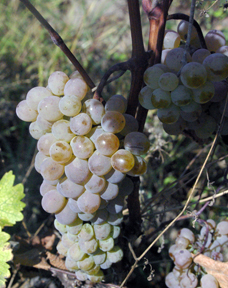 Rkatsiteli Under a warm sun, Kathy and I began harvesting in the original Napa, a small town in the Kakheti region of the country Georgia called Napareuli. Knowledgeable harvesters were in the vineyards at 6:00 am. By 11:00 am the sun was sharing it warmth. We were picking Rkatsiteli, the most planted white variety in Georgia. Using a knife and basket, we proceeded down a row. It didn’t take long for the basket to fill, and there was always someone to pick it up, take it to a cart and dump the grapes. The basket was returned and we continued cutting grape bunches from the vines with a knife.
Although adults were in the vineyards, so were children. Two of the youngest children decided to take a break and sit on the shady side of a row of vines, singing songs. The children were ever attentive to any of our needs, getting our baskets and bringing water so we could wash our hands (picking grapes gets sticky after awhile). English is taught in the schools and the children could speak some English. We asked one of the older girls how long she had helped with harvest. She commented, all of her life. Families involved in the grape harvest, called Rtveli, dates back to ancient times.
While harvesting, I reflected on the history of this land. Grapes have been cultivated, harvested and made into wine for 8,000 years. Long before the Ancient Greeks and Romans grew grapes and made wine, the land in the Kakheti region had families in vineyards picking grapes under the warm September sunshine.
Cheers,
Terry
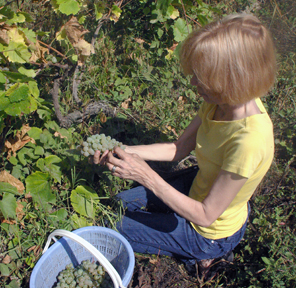 Kathy examines the grape bunches. We removed any MOG and grapes that we didn’t want in the wine.
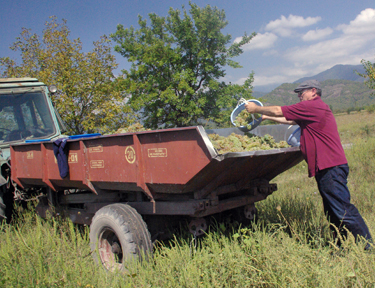 After this cart was filled, the grapes were taken to Twins Wine Cellar. Trucks filled with grapes were constantly transporting grapes to the wineries in Kakheti, reminding me of a September visit to Sonoma.
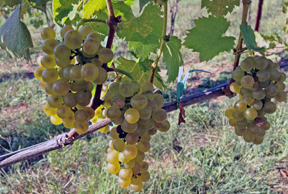 Kathy and I had an opportunity to harvest Viognier at Catoctin Breeze Vineyard in Thurmont, Maryland last week. It was our second harvest this year. Our first experience was harvesting the red grape Lenoir at Messina Hof in Bryan, Texas. The Viognier grapes were just a tad more challenging to pick. Because of their light color, they would sometimes hide from us. We had to look carefully not to miss any clusters. Kathy and I had an opportunity to harvest Viognier at Catoctin Breeze Vineyard in Thurmont, Maryland last week. It was our second harvest this year. Our first experience was harvesting the red grape Lenoir at Messina Hof in Bryan, Texas. The Viognier grapes were just a tad more challenging to pick. Because of their light color, they would sometimes hide from us. We had to look carefully not to miss any clusters.
We also did some sorting in the vineyard. Grapes that were extremely small were removed from the cluster, a task easier to do if you have smaller fingers. There were a few berries removed that may have been showing signs of disease. Most of the time, we removed MOG or materials other than grapes. There wasn’t a lot of MOG to remove. Occasionally there was a stray tendril or leaf to pull out of the cluster. Rarely were their insects in a cluster, but I did remove a couple ants and a couple earwigs. Kathy did find one stink bug. Sorting while picking did slow us down a bit, but wasn’t hard.
What surprised me the most was it took two hours to individually harvest the Viognier in one row. The last two rows went much faster as it was a group effort. There were five volunteers picking the grapes. It seems that we work better if two of us are working on the same row on opposite sides of the vines. Granted that we do spend time talking, but this is the age of multi-tasking and talking and harvesting are two tasks that can be done at the same time.
After harvest, we settled in some lawn chairs and had a glass of wine or a beer. More people drank wine than beer. After a while of relaxing and conversation, we had a wonderful lunch on the patio next to the tasting room. The winemaking crew joined us for lunch. They had been pressing the grapes we were picking earlier.
I remember our first harvest experience many years ago. It took a long time to fill a lug. We haven’t had many experiences harvesting grapes, but we have increased our pace over our first experience. We can fill a lug in just a few minutes compared to 30 minutes back in 2007. However, we lag way behind the professional harvesters we observed in Suisun County. They can harvest a lug of grapes in what seems like seconds. We will have to see our speed with our next harvest in the country Georgia.
Cheers,
Terry
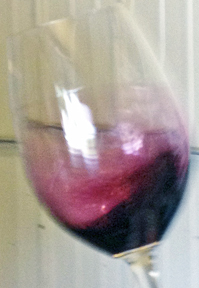 Kathy and I went to Tin Lizzie Wineworks to taste our 2012 Cabernet Sauvignon. It has been in the Taransaud barrel for ten months and we wanted to check on how the wine is at this point. The first note was its color. The wine was a very dark ruby to black color. The opaque colored wine had a light ruby rim. I noticed cassis on the aroma and taste. I wasn’t sure of the cassis profile for a wine descriptor until our visit to France in July. I had the opportunity to taste several fruit wines made entirely out of cassis. Our 2012 Cabernet Sauvignon reminded me of cassis. There was also a hint of plum on the taste. The tannins were quite noticeable, expected after being in a new French oak barrel for ten months. The tannins were big, bold and chewy. It will be interesting to note how these tannins will change over the next year in the barrel. Kathy and I went to Tin Lizzie Wineworks to taste our 2012 Cabernet Sauvignon. It has been in the Taransaud barrel for ten months and we wanted to check on how the wine is at this point. The first note was its color. The wine was a very dark ruby to black color. The opaque colored wine had a light ruby rim. I noticed cassis on the aroma and taste. I wasn’t sure of the cassis profile for a wine descriptor until our visit to France in July. I had the opportunity to taste several fruit wines made entirely out of cassis. Our 2012 Cabernet Sauvignon reminded me of cassis. There was also a hint of plum on the taste. The tannins were quite noticeable, expected after being in a new French oak barrel for ten months. The tannins were big, bold and chewy. It will be interesting to note how these tannins will change over the next year in the barrel.
At this point in the wine’s journey, it is showing great potential. The tannins will soften, hopefully the fruit will evolve and the wine will pick up some aromas and tastes of wood. Those were not very noticeable with perhaps just a hint of leather and licorice. We are pleased with our selection of a Taransaud barrel and looking forward to what another year in this barrel can do.
Cheers,
Terry
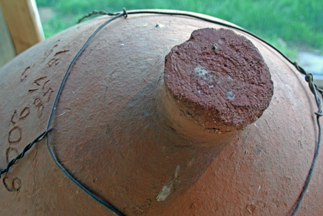 Bottom of qvevri used at Castle Hill Cider in Keswick, Virginia Take a tour of most wineries in the United States and you will notice most have stainless steel tanks and oak barrels. Some will ferment in these as well as age wine in these vessels. Plastic bins are also popular for fermenting small batches of grapes. There are also plastic tanks that you may see while visiting wineries. In France, earlier this summer, we saw many cement tanks. They are popular in France because they are made in the winery to a specific capacity, often corresponding to a vineyard plot. In Croatia earlier this year we observed oak barrels as well as barrels made from acacia.
What vessel has been used the longest for fermenting and aging wines? For the answer one should visit wineries in the country Georgia. Viticulture and winemaking were firmly established in the region south of the Caucasus Mountains for several millennia prior to the introduction viticulture and winemaking to western Europe. People living in the land now encompassing Georgia have been making wine for 6,000 – 8,000 years. Clay pots have been found dating back to before 4,000 BCA; they were used for fermentation and to age wine.
Qvevri are large clay vessels used to ferment grapes and age wine. They are used today in Georgia and have been continuously used for these processes for thousands of uninterrupted years. This would make qvevri the oldest type of vessel for winemaking. If one were to make a timeline of winemaking through the ages, stainless steel tanks would be just a pin hole on the timeline. Qvevri would take up most of the timeline. More qvevri are made in Georgia as many of the Georgian wineries are making traditional qvevri wines.
Although there are variations on the theme, grapes are harvested and placed in the qvevri that are buried in the ground to maintain a constant temperature. Fermentation and aging is done in the qvevri. About six months later, the qvevri are opened and the wine is sampled. A well-made qvevri white wine is often a deep golden transparent color and fruit forward. Qvevri wines can age, once bottled, for many years. Using qvevri is perhaps the best vessel for winemaking that allows a grape to express itself.
Want to learn more about using qvevri in winemaking? The 2014 International Wine Tourism Conference will take place in Tbilisi, Georgia on March 28th and 29th. Check out the conference and sample some qvevri wines.
Cheers,
Terry
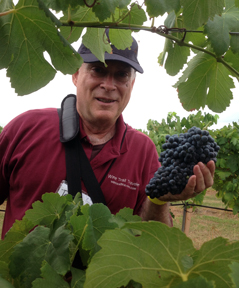 Harvesting grapes may seem romantic, but it’s work. Our first harvest was at a Maryland winery. It was a hot day and the sun was beating down on the vineyard as we began around 9:00 am. It took Kathy and me about an hour and a half to fill two lugs. Then we were put to shame when we watched professional harvesters fill a lug in minutes in California. We were determined to do a better job at harvesting. Harvesting grapes may seem romantic, but it’s work. Our first harvest was at a Maryland winery. It was a hot day and the sun was beating down on the vineyard as we began around 9:00 am. It took Kathy and me about an hour and a half to fill two lugs. Then we were put to shame when we watched professional harvesters fill a lug in minutes in California. We were determined to do a better job at harvesting.
Our opportunity to redeem ourselves occurred yesterday at Messina Hof Winery in Bryan, Texas. We were visiting Messina Hof for a reunion of the media that attended the 2012 International Wine Tourism Conference that was held in Umbria, Italy. We were expecting another sun-drenched day with high temperatures. However, you can not always write a script for harvest. You get what nature hands you for better or worse. In this case it was for the better.
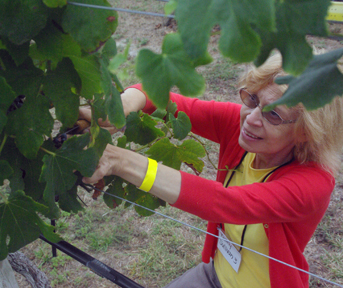 The morning started off cloudy with a slight breeze. After an orientation a group of 150 people headed to the vineyard to pick Lenoir also know as Black Spanish. What a difference. People were really on task picking the grape clusters and filling their lugs. Kathy and I filled three lugs in about thirty minutes. Still not at a professional level, but definitely outpacing our last harvest attempt. The morning started off cloudy with a slight breeze. After an orientation a group of 150 people headed to the vineyard to pick Lenoir also know as Black Spanish. What a difference. People were really on task picking the grape clusters and filling their lugs. Kathy and I filled three lugs in about thirty minutes. Still not at a professional level, but definitely outpacing our last harvest attempt.
It was quite easy to harvest Lenoir. Kneeling made cutting the clusters, with a curved knife, easy. Most of the clusters were near the bottom or slightly above the bottom of the grapevine. The Lenoir clusters were large and easy to locate. The majority of the grapes were ripe and very few green grapes were in any of the clusters. With 150 people, as a group we harvested grapes in a row rather quickly. For a short morning activity, three tons of grapes were harvested. It was nice to have redemption for our first harvest attempt.
Cheers,
Terry
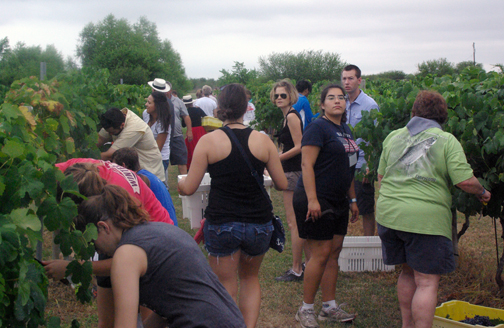 Lenoir harvest at Messina Hof Winery.
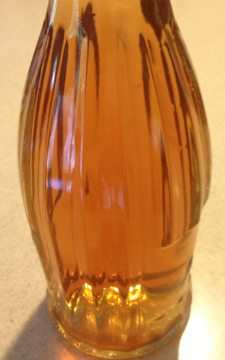 Finally managed to bottle the 2012 White Cabernet Sauvignon made with juice from Thanksgiving Farm in Harwood, Maryland. The wine was in carboys in the refrigerator for the last two plus months taking up valuable real estate. The reason it took so long to get it bottled is that I didn’t have enough bottles. We had to drink a few more white wines to provide bottles for the new wine. That took awhile considering we have had below average temperatures for several months and so far May of 2013 continues to follow the trend. I tend to drink fewer white wines in cold/cooler weather than I do in warm/hot weather. Finally managed to bottle the 2012 White Cabernet Sauvignon made with juice from Thanksgiving Farm in Harwood, Maryland. The wine was in carboys in the refrigerator for the last two plus months taking up valuable real estate. The reason it took so long to get it bottled is that I didn’t have enough bottles. We had to drink a few more white wines to provide bottles for the new wine. That took awhile considering we have had below average temperatures for several months and so far May of 2013 continues to follow the trend. I tend to drink fewer white wines in cold/cooler weather than I do in warm/hot weather.
So why did I make a White Cab? Over the past few years, Kathy and I have visited several wineries that had a White Pinot Noir, White Merlot and White Cabernet Franc. Since Cabernet Sauvignon is my favorite grape for wine making, I thought about a White Cabernet Sauvignon. Chris Pearmund gave me a couple gallons of Virginia Cabernet Sauvignon juice and I received several gallons from Thanksgiving Farm for a Maryland White Cab. We bottled the Virginia White Cab months ago and finally opened a bottle. Wow! Very fruit forward but with red berry fruit. I was drinking more of the Virginia White Cab today and am getting strawberry and rhubarb notes. I tasted the Maryland White Cab and it too was very fruity.
Now that I have my White Cabernet Sauvignon experiment in bottles bring on the 90º weather. I wanted to make a wine that would be a good apéritif served cold on a hot day during the summer. So far, I’m happy with the way this White Cab turned out. I like the orange/salmon color and the red berry fruit notes.
Cheers,
Terry
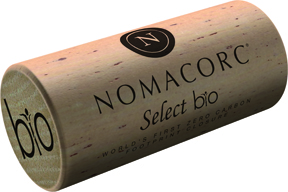 Image provided by Nomacorc. What do you do with all those wine bottle closures? We don’t throw them in the trash because they are not biodegradable. So they fill up a box, then another box until we make something out of them. I’ve made wine bottle trivets, push pin boards and even cut the corks on a band saw to make quarter round for molding. Some people live near a winery or wine shop that will collect the corks for recycling. I never seem to just throw them away.
Now the manufacturer Nomacorc has developed a closure that is made using renewable plant-based materials. This is the first zero carbon footprint closure on the market and will be presented at the Intervitis Interfructa trade show April 24 – 27, 2013 in Stuttgart, Germany. The closures will become available for the 2014 bottling. These closures will be 100 percent recyclable.
What wineries may be interested in these closures? It looks like Nomacorc is aiming the closures to wineries that are sustainable, organic or biodynamic. Many of those wineries are trying to reduce their carbon footprint and using these closures will afford another opportunity to do that. According to a press release by the manufacturer, “As with other Select Series products, Select Bio will minimize the environmental impact of wines by preventing spoilage and waste from wine faults such as oxidation and reduction. By consistently delivering the right amount of oxygen into the bottle using a carbon neutral closure, sustainability-minded wineries will now be able to deliver their wines just as they intend.”
Expect to see more information and marketing for these closures in the future. Will wineries show an interest in extending their sustainability practices? Will consumers know that difference and pitch these closures into the trash? Perhaps I’ll need one more box and start collecting them for a future project.
Cheers,
Terry
|
|
 Although we were not present at Twins Wine Cellars at Napareuli to punch down our cap, we did punch down the cap on a large capacity qvevri at the winery. Our previous experience of punching down was at Tin Lizzie Wineworks in Clarksville, Maryland last fall. Kathy and I went to the winery daily and punched down the cap of our fermentation bin and several other clients’ fermentation bins. The caps in the fermentation bins were four to six inches thick. Punch down required a litter effort the first time you punch through the cap, but it was easy after that. Punching down the cap in a large capacity qvevri is an entirely different experience.
Although we were not present at Twins Wine Cellars at Napareuli to punch down our cap, we did punch down the cap on a large capacity qvevri at the winery. Our previous experience of punching down was at Tin Lizzie Wineworks in Clarksville, Maryland last fall. Kathy and I went to the winery daily and punched down the cap of our fermentation bin and several other clients’ fermentation bins. The caps in the fermentation bins were four to six inches thick. Punch down required a litter effort the first time you punch through the cap, but it was easy after that. Punching down the cap in a large capacity qvevri is an entirely different experience.


















